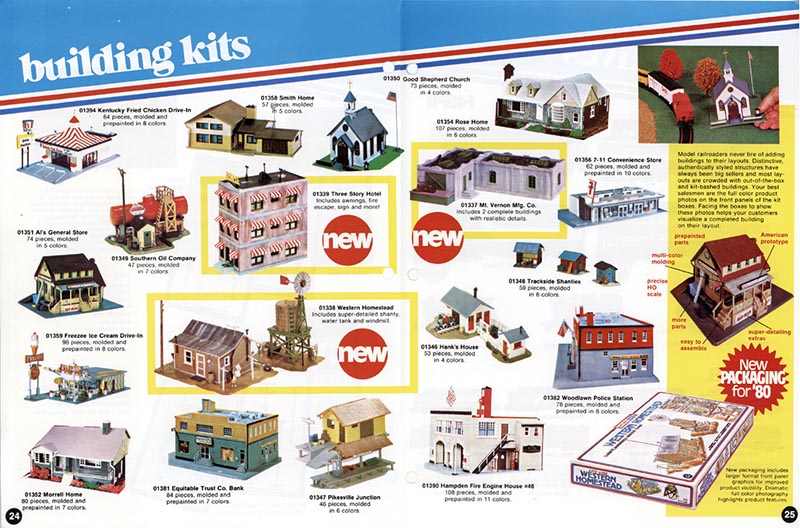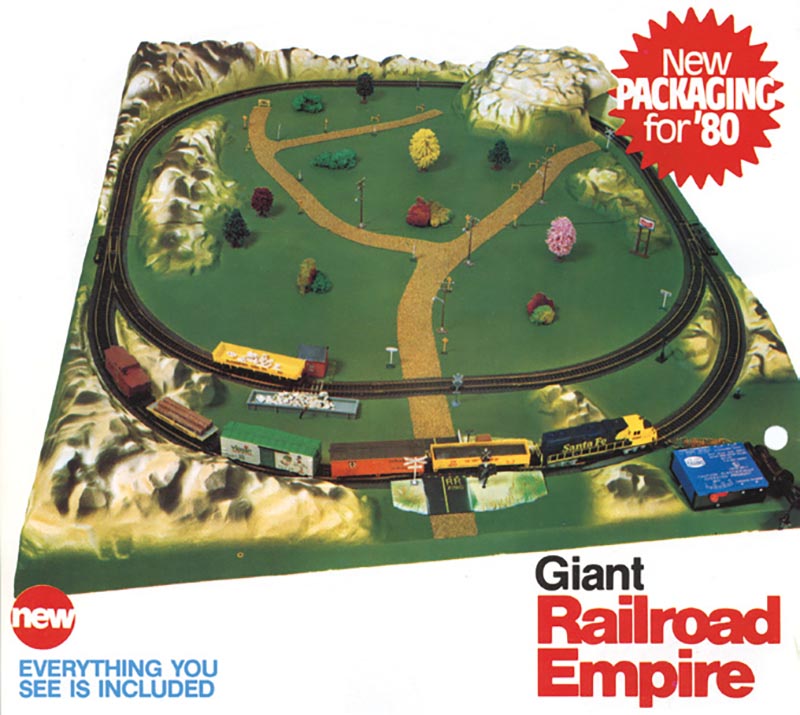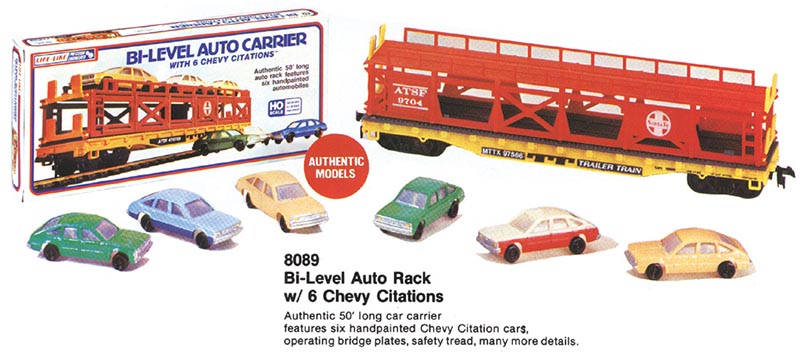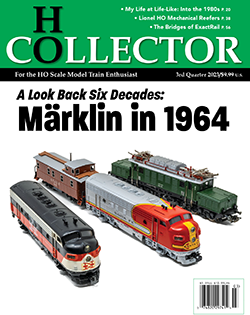Train-Miniature, Wai Shing Ting, and the Roach Ranch
In 1979 or 1980, Life-Like purchased the tooling for eight building kits from Train-Miniature. The company’s locomotive and freight car kits went elsewhere (first to a new owner that branded them Train-Miniature of Illinois, Ltd., and by the late 1980s Walthers began returning these models to market under its own brand name). The kits Life-Like purchased were: Three Story Hotel (TM-7058), Small Industrial Plant (TM-7062), Elevated Coal Trestle (TM-7060), and five kits making up Train-Miniature’s Old West Town: General Store or Bank (TM-7054), Old Time Saloon (TM-7053), Stone Jail (TM-7052), Line Side Shanty (TM-7051), and Water Tank & Windmill (TM-7050).
After the purchase, Life-Like’s Marketing Services received test shots in a tan styrene molded from the tooling of all the kits, any surviving artwork for packaging and instructions, and at least three beautifully decorated kits in acrylic display boxes. One box had the shanty kit; the other two boxes had freight yard buildings that each used one TM maintenance-of-way carbody on a foundation. We put those latter two in our back room because Life-Like didn’t get the tooling for them.

ABOVE: The 1980 collection of HO structure kits included selections from a recently acquired group of Train-Miniature assets, which included Ulrich-heritage molds.
In an earlier installment, I mentioned the huge roaches that lived in the factory and our offices on Union Avenue, attracted by the stored raw lichen. We decided to make our own version of a hamster habitat for roaches for our office. We started with the clear acrylic top from one of the TM display models and a foam merchandiser tray for smoke bottles from the plant. The tray had 12 round cavities to hold 2-ounce glass bottles of smoke fluid with droppers. John cut passageways between the openings like a maze. Under the acrylic box on one end of the tray, John planted two Life-Like “Giant Trees.” Someone tossed in some candy for food. A sheet of clear acetate sealed the top of the tray not covered by the box. We named it the “Roach Ranch” and put it on a file cabinet in the part of the office where the illustrators and I sat. We trapped two large roaches and put them in the ranch. We marveled at how they climbed the trees and looked around the room while waving their antennas. We periodically added a roach or two until we had seven on the ranch.
Then we learned Wai Shing Ting was coming to the U.S. and would be visiting Life-Like, including our office. Jay told us to hide the Roach Ranch while Ting was there. At the time, few in our department had any idea how important Mr. Ting was to the hobby in general and Life-Like in particular; the Kramers could hardly be considered compulsive communicators to folks at our level. Anyway, we moved the Roach Ranch into the back room, and briefly met Ting when he visited Marketing Services.

ABOVE: Above: Like-Like’s train set offerings included additional features that many competitors either lacked in their product line (like a foam layout base) or did not incorporate into starter releases (like scenery items and signs). This set carried a suggested retail price of around $150 in the early 1980s.
Product Development in the 1980s
In the July 1980 employee newsletter, I described the steps in the process we used to create new products. As time went on, I got more opportunities to get involved in the process. I often contributed in the brainstorming phase and worked on proposals from Marketing Services. As items were approved, I became involved in research and design that would be used for the tooling, painting, lettering, instruction sheets, and package design and text. I once asked Jay Kramer why we didn’t do market research to find out what consumers wanted, as I had been trained in college. He said it wasn’t necessary because “We know the business better than the customers do; we know what they want.” I didn’t agree. [Life-Like was hardly alone in such sentiment, which was infamously typical of contemporary boardrooms. The consumer market has certainly changed! —Ed.] New products often required lots of lead time, and any single one may have had John, me, neither, or both of us involved in development.
New Products for 1980
Brand new for 1980 were Giant Trees: Giant Juniper (1018), Giant Chestnut (1019), Giant Blue Spruce (1010), and Giant Magnolia (1016); Track Cleaner (1416) in a new size (4 ounces) with revised packaging (blis-ter card); Smoke (1417) in a new size (2 ounces) with blister-card packaging; Build-A-Rama (1177), which was a box of various landscaping supplies for an HO layout (two house kits, a church kit, and details); Super Light-Ups, which were slightly oversized light-ups that relied on a 12-volt bulb in the base and clear plastic rods to transfer the light to the lenses; Lighted Crossing Gate (1233) offered with two per package; Road Barrier (1232) three per package; Semaphore (1231); and Expressway Lights (1504), which was a pair of modern streetlights made of metal tubing with a metal reflector, plastic base, and 12-volt grain of wheat bulb. Arguably Life-Like’s best quality streetlights; they were slightly better than ones previously introduced by AHM.

ABOVE: The motive power roster found in Life-Like’s 1982 catalog included a trio of steam locomotives listed as “Ol’ Timers” (lower center of page), along with the recently intro-duced F40PH (far left), GP38-2 (far right), and the Penn Line/Varney heritage tooling F7A and F7B diesel locomotive offerings. The F7 drive received an updated design at this time.
Billboard (1215) consisted of a pair of plastic signs with Campbell’s Soup ad being new, to fit an unrelated promotion (see “Campbell’s Trainload of Good Foods in HOC’s First Quarter 2022 edition). The Train Maintenance Kit (8629) included track cleaner, oil, grease, track cleaning eraser, and a circuit tester called a Trouble Shooter (essentially a 12-volt bulb with two leads). The Switch Machine (8612) and Switch Control (8613) provided replacement parts for remote-control switches based on an old Atlas design.
Life-Like’s “Giant Railroad Empire” (1540) was a starter set with a two-piece, painted, foam layout. Equipment included a Santa Fe GP38-2 diesel locomotive, log dump car, gravel dump car, boxcar, reefer, gondola, caboose, track, two manual switches, power pack, crossing gate, trees, signs, and some landscaping materials. Also provided were multi-page guides “Hobby Railroading With a Train Set” (8011) and “Hobby Railroading Wiring and Lights” (8012), to help beginners establish a model railroad…




